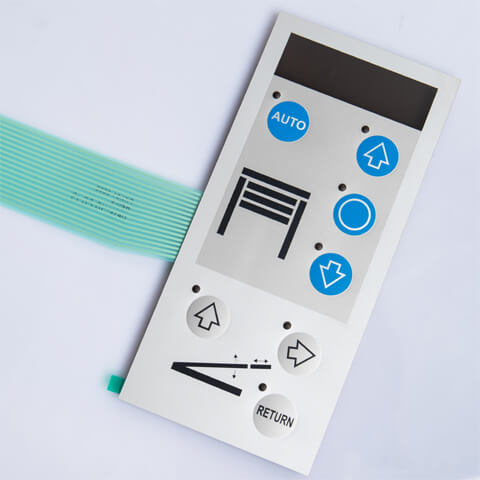Essential Features to Look for When Selecting a Membrane Switch
Essential Features to Look for When Selecting a Membrane Switch
Blog Article
Recognizing the Functionality of Membrane Layer Switches for Customer Interface Tools
The functionality of membrane layer changes represents a considerable development in individual interface design, integrating performance with aesthetic convenience. As industries significantly focus on user experience, comprehending the subtleties of membrane button innovation comes to be important.
What Are Membrane Buttons?
Membrane layer switches are ingenious user interface tools that promote user interaction with electronic equipment. These versatile parts include multiple layers, consisting of a visuals overlay, spacer, and a published circuit layer. The layout permits a seamless combination into different electronic devices, boosting both the visual and useful facets of customer interfaces.
Membrane layer buttons are generally employed in a broad range of applications, from home appliances to industrial equipment and clinical gadgets. Their building typically includes a slim profile, making them an optimal option for compact styles. The responsive responses given by these buttons can be engineered to meet specific customer preferences, guaranteeing effective interaction in between the individual and the device.
Resilience is an additional substantial benefit of membrane buttons, as they are resistant to dust, dampness, and chemicals, which improves their life expectancy sought after environments. In addition, these buttons can be customized in regards to shape, dimension, and visuals style, allowing for branding and user-specific attributes. In general, membrane changes represent a practical service for boosting individual experience in digital gadgets, incorporating performance with visual charm in an efficient way.
How Membrane Layer Switches Job
Operating on a straightforward concept, membrane switches over utilize a split construction to sign up user input successfully. Each switch contains numerous layers, including a published circuit layer, a spacer layer, and a top graphic layer, which are made to work together flawlessly. When a user presses the leading layer, it compresses the spacer layer, bringing the conductive aspects of the circuit layer right into call with each other.
This call develops a shut circuit, indicating the tool to implement a certain function. The design enables various setups, consisting of responsive feedback, which can boost the user experience by giving a physical sensation upon activation. The materials utilized in membrane switches commonly consist of adaptable substratums, such as polyester or polycarbonate, which ensure longevity and durability against damage.

Trick Benefits of Membrane Layer Buttons

Another considerable benefit is their compactness. Membrane layer switches are slim and light-weight, which makes it possible for suppliers to conserve area in their gadgets without sacrificing functionality. This attribute is especially helpful in applications where weight and quantity are vital factors to consider.
Furthermore, membrane buttons are immune to dust, wetness, and chemicals, boosting their sturdiness. This strength expands their life expectancy and decreases the requirement for constant replacements, causing cost savings in time.
In addition, the tactile feedback given by membrane layer buttons can be enhanced to improve individual communication. They can consist of features such as increased switches or audible clicks, improving usability and user experience.
Applications Across Industries
Interface tools making use of membrane layer buttons prevail in published here a broad selection of markets, showcasing their versatility and performance. Membrane Switch. In the clinical industry, membrane buttons are integral to gadgets such as analysis equipment and client monitoring systems, where their resilience and convenience of cleaning are crucial for maintaining hygiene requirements. In the auto sector, these switches are employed in control panel controls and infotainment systems, providing a sleek and modern user interface for customers.
Additionally, the customer electronic devices sector gain from membrane layer buttons in appliances and portable gadgets, where small layout and easy to use user interfaces improve individual experience. Industrial applications also take advantage of membrane layer switches over for control board in equipment and automation systems, highlighting their toughness and resistance to harsh atmospheres.
In the aerospace and defense markets, membrane layer switches are utilized in cabin controls and devices, where dependability and performance under extreme problems are critical. Additionally, the gaming industry progressively incorporates membrane switches in controllers and gallery machines, adding to an appealing customer experience. Generally, the flexibility of membrane changes enables their extensive use across numerous sectors, emphasizing their importance in modern user interface style.
Future Patterns in Membrane Switch Over Technology

In addition, using sophisticated materials, such as polycarbonate and polyester films, is expected to climb, offering improved longevity and resistance to ecological stress factors. These materials add to the overall longevity of membrane buttons, making them ideal review for harsher commercial applications.
Moreover, the unification of smart innovation, consisting of IoT connection, will allow membrane buttons to communicate with other tools and systems, assisting in a much more interactive customer experience. This fad straightens with the growing need for smart tools throughout various fields, from medical care to customer electronics.
Finally, customization choices are anticipated to increase, enabling makers to produce bespoke remedies tailored to particular customer requirements and preferences. These advancements will certainly position membrane buttons as essential parts in the advancement of interface modern technology.
Verdict
To conclude, membrane layer changes stand for a visit this site right here pivotal innovation in user interface technology, using a reliable and functional service for diverse digital applications. Their split building assists in portable style, while features such as responsive comments boost individual communication. The toughness versus ecological factors further solidifies their utility throughout numerous markets. As advancements in product scientific research and touch noticing modern technologies continue, the capability and applicability of membrane layer buttons are expected to broaden, enhancing their value in contemporary digital tools.
Report this page